The AI Inflection Point in Finance: Why Treasury Leaders Can't Wait


Corporate treasurers face an unprecedented moment of opportunity. While market volatility increases and regulatory complexity grows, a new technological foundation is emerging that can transform these challenges into competitive advantages. With 79% of CFOs increasing their AI budgets in 2025, we're witnessing a fundamental change that will define the next decade of treasury operations.
The question facing treasury leadership today centers not on whether to adopt artificial intelligence, but on how quickly and strategically to implement it.
How is AI Supporting Treasury Leaders?
Treasury functions implementing AI ahead of their peers are gaining a strong competitive advantage. Meanwhile, companies that delay AI implementation risk being permanently disadvantaged as AI-native competitors emerge with fundamentally superior cost structures and decision-making capabilities.
The evidence extends beyond efficiency gains. Organizations leveraging AI in treasury operations report:
- 71% of companies are using AI in finance, with 92% reporting their AI initiatives are meeting or exceeding ROI expectations
Beyond the Hype: What Finance Leaders Really Want
This AI revolution differs from previous technology waves in a crucial way: CFOs are demanding both efficiency and explainability. Finance leaders understand that in a world of regulatory scrutiny and fiduciary responsibility, trust represents an essential requirement rather than a nice-to-have feature.
This sophisticated approach aligns with McKinsey's latest State of AI findings. The most successful organizations aren't just implementing AI tools; they're fundamentally redesigning their workflows. 21% of companies using generative AI have completely reimagined how work gets done. Even more striking: 28% of organizations now have their CEO personally overseeing AI governance.
Why the C-suite involvement? Because smart leaders understand that AI transformation equals organizational transformation. Success depends on having the clearest vision for how humans and AI collaborate to create value, rather than simply having the best algorithms.
Moving from Automation to Amplification
Here's where many organizations stumble. They approach AI as a better version of robotic process automation, focusing on faster, smarter task completion. However, the real opportunity lies in augmenting human intelligence, not replacing it.
Consider the treasury professional who spends every Thursday generating forecast comparison reports: exporting to Excel, analyzing variances line by line, writing executive summaries, formatting presentations. Four to eight hours gone every single week. Two full months a year spent on manual analysis.
The automation mindset says: "Let's make this faster." The amplification mindset asks: "What strategic insights are we missing while buried in manual work?"
Automation saves time, but amplification creates competitive advantages.
Security Can't Be an Afterthought
As finance leaders embrace AI, they're rightly demanding more than promises about data security. The organizations succeeding with AI have built trust from the ground up:
- Data sovereignty – Maintaining complete control over where data lives and how it's processed
- Inference-only models – Ensuring proprietary data never becomes training material for AI systems
- Transparent reasoning – Providing clear audit trails showing how AI reaches its conclusions
- Human oversight – Keeping decision-makers in the loop for all material recommendations
These are business imperatives rather than technical requirements. In finance, you must be able to prove you were right.
Rethinking How Work Gets Done
The most successful AI implementations fundamentally reimagine existing processes. This requires answering three critical questions:
- Is it high frequency? – Tasks performed regularly offer the best ROI for AI investment
- Is it high pain? – Time-consuming, error-prone processes that drain strategic capacity
- Is it ready for AI amplification? – Complex pattern recognition or analysis that benefits from machine intelligence
When treasury teams apply this framework, they often discover that their biggest AI opportunities lie in surfacing insights that were previously impossible to generate at scale, rather than simply automating routine tasks.
The Risk Management Paradigm Shift
Traditional risk management is fundamentally reactive. Risk policies trapped in PDFs, exposures scattered across spreadsheets, breaches discovered after month-end, sometimes after quarter-end.
AI enables a shift from reactive to predictive risk management. Instead of finding violations after they've impacted hedging costs or covenant compliance, intelligent systems can monitor exposures continuously and alert teams before breaches occur.
This represents strategic transformation, not just operational improvement. When risk management becomes predictive, treasury teams can shift from crisis response to strategic positioning.
How Do You Build A Treasury AI Strategy?
Organizations successfully implementing AI in finance share common characteristics:
- AI-first mindset
- Culture of experimentation
- Outcome-driven innovation
- Customer-centric development
Perhaps most importantly, they understand that AI transformation doesn't start with technology. Instead, it begins with conviction about what's possible when your best people are freed from operational difficulties.
Conclusion
The market is already separating into leaders and followers; the organizations that move decisively will establish sustainable competitive advantages. Those that wait will find themselves playing catch-up in an increasingly AI-native business environment.
The question centers not on whether AI will transform treasury operations, but on whether you'll lead that transformation or be forced to follow it.
The opportunity is unprecedented. The tools are mature. The only remaining variable is leadership conviction. In a world where 79% of your peers are increasing AI investments, standing still is actually moving backward.
Learn about how GTreasury’s GSmart AI can support your organization by scheduling a demo with our team of treasury experts.
The AI Inflection Point in Finance: Why Treasury Leaders Can't Wait
Corporate treasurers face an unprecedented moment of opportunity. While market volatility increases and regulatory complexity grows, a new technological foundation is emerging that can transform these challenges into competitive advantages. With 79% of CFOs increasing their AI budgets in 2025, we're witnessing a fundamental change that will define the next decade of treasury operations.
The question facing treasury leadership today centers not on whether to adopt artificial intelligence, but on how quickly and strategically to implement it.
How is AI Supporting Treasury Leaders?
Treasury functions implementing AI ahead of their peers are gaining a strong competitive advantage. Meanwhile, companies that delay AI implementation risk being permanently disadvantaged as AI-native competitors emerge with fundamentally superior cost structures and decision-making capabilities.
The evidence extends beyond efficiency gains. Organizations leveraging AI in treasury operations report:
- 71% of companies are using AI in finance, with 92% reporting their AI initiatives are meeting or exceeding ROI expectations
Beyond the Hype: What Finance Leaders Really Want
This AI revolution differs from previous technology waves in a crucial way: CFOs are demanding both efficiency and explainability. Finance leaders understand that in a world of regulatory scrutiny and fiduciary responsibility, trust represents an essential requirement rather than a nice-to-have feature.
This sophisticated approach aligns with McKinsey's latest State of AI findings. The most successful organizations aren't just implementing AI tools; they're fundamentally redesigning their workflows. 21% of companies using generative AI have completely reimagined how work gets done. Even more striking: 28% of organizations now have their CEO personally overseeing AI governance.
Why the C-suite involvement? Because smart leaders understand that AI transformation equals organizational transformation. Success depends on having the clearest vision for how humans and AI collaborate to create value, rather than simply having the best algorithms.
Moving from Automation to Amplification
Here's where many organizations stumble. They approach AI as a better version of robotic process automation, focusing on faster, smarter task completion. However, the real opportunity lies in augmenting human intelligence, not replacing it.
Consider the treasury professional who spends every Thursday generating forecast comparison reports: exporting to Excel, analyzing variances line by line, writing executive summaries, formatting presentations. Four to eight hours gone every single week. Two full months a year spent on manual analysis.
The automation mindset says: "Let's make this faster." The amplification mindset asks: "What strategic insights are we missing while buried in manual work?"
Automation saves time, but amplification creates competitive advantages.
Security Can't Be an Afterthought
As finance leaders embrace AI, they're rightly demanding more than promises about data security. The organizations succeeding with AI have built trust from the ground up:
- Data sovereignty – Maintaining complete control over where data lives and how it's processed
- Inference-only models – Ensuring proprietary data never becomes training material for AI systems
- Transparent reasoning – Providing clear audit trails showing how AI reaches its conclusions
- Human oversight – Keeping decision-makers in the loop for all material recommendations
These are business imperatives rather than technical requirements. In finance, you must be able to prove you were right.
Rethinking How Work Gets Done
The most successful AI implementations fundamentally reimagine existing processes. This requires answering three critical questions:
- Is it high frequency? – Tasks performed regularly offer the best ROI for AI investment
- Is it high pain? – Time-consuming, error-prone processes that drain strategic capacity
- Is it ready for AI amplification? – Complex pattern recognition or analysis that benefits from machine intelligence
When treasury teams apply this framework, they often discover that their biggest AI opportunities lie in surfacing insights that were previously impossible to generate at scale, rather than simply automating routine tasks.
The Risk Management Paradigm Shift
Traditional risk management is fundamentally reactive. Risk policies trapped in PDFs, exposures scattered across spreadsheets, breaches discovered after month-end, sometimes after quarter-end.
AI enables a shift from reactive to predictive risk management. Instead of finding violations after they've impacted hedging costs or covenant compliance, intelligent systems can monitor exposures continuously and alert teams before breaches occur.
This represents strategic transformation, not just operational improvement. When risk management becomes predictive, treasury teams can shift from crisis response to strategic positioning.
How Do You Build A Treasury AI Strategy?
Organizations successfully implementing AI in finance share common characteristics:
- AI-first mindset
- Culture of experimentation
- Outcome-driven innovation
- Customer-centric development
Perhaps most importantly, they understand that AI transformation doesn't start with technology. Instead, it begins with conviction about what's possible when your best people are freed from operational difficulties.
Conclusion
The market is already separating into leaders and followers; the organizations that move decisively will establish sustainable competitive advantages. Those that wait will find themselves playing catch-up in an increasingly AI-native business environment.
The question centers not on whether AI will transform treasury operations, but on whether you'll lead that transformation or be forced to follow it.
The opportunity is unprecedented. The tools are mature. The only remaining variable is leadership conviction. In a world where 79% of your peers are increasing AI investments, standing still is actually moving backward.
Learn about how GTreasury’s GSmart AI can support your organization by scheduling a demo with our team of treasury experts.

See GTreasury in Action
Get connected with supportive experts, comprehensive solutions, and untapped possibility today.
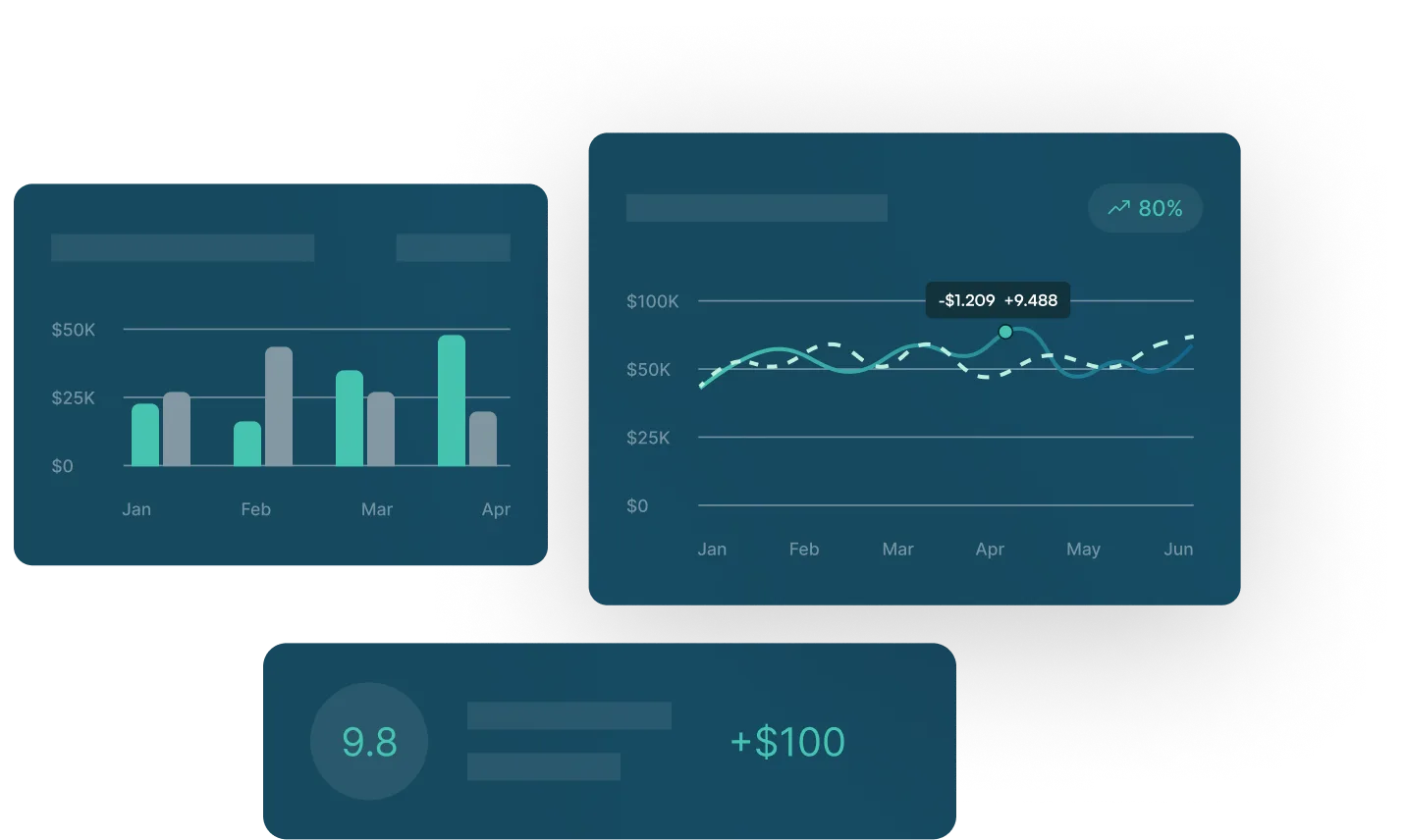


























.png)

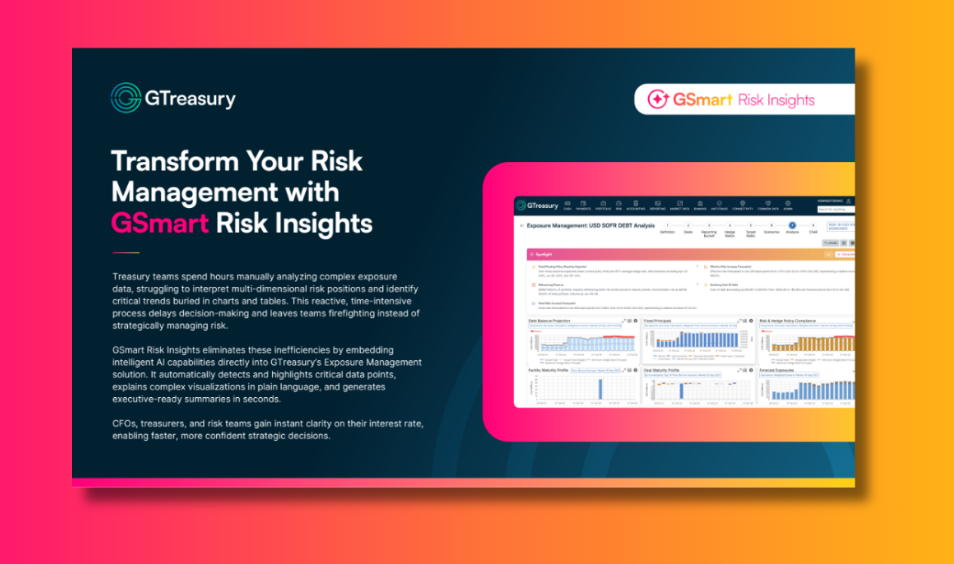
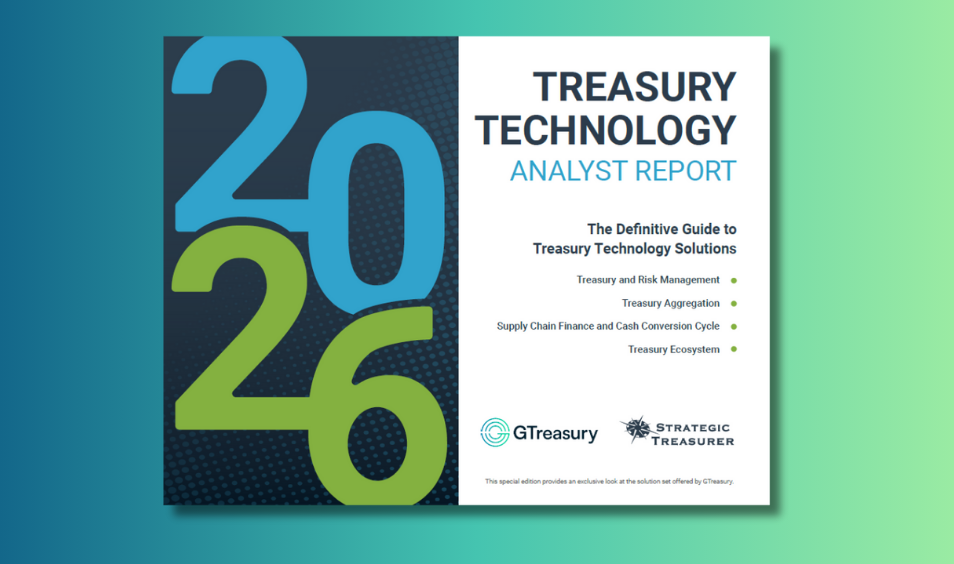




.png)
.png)













.png)

.png)





















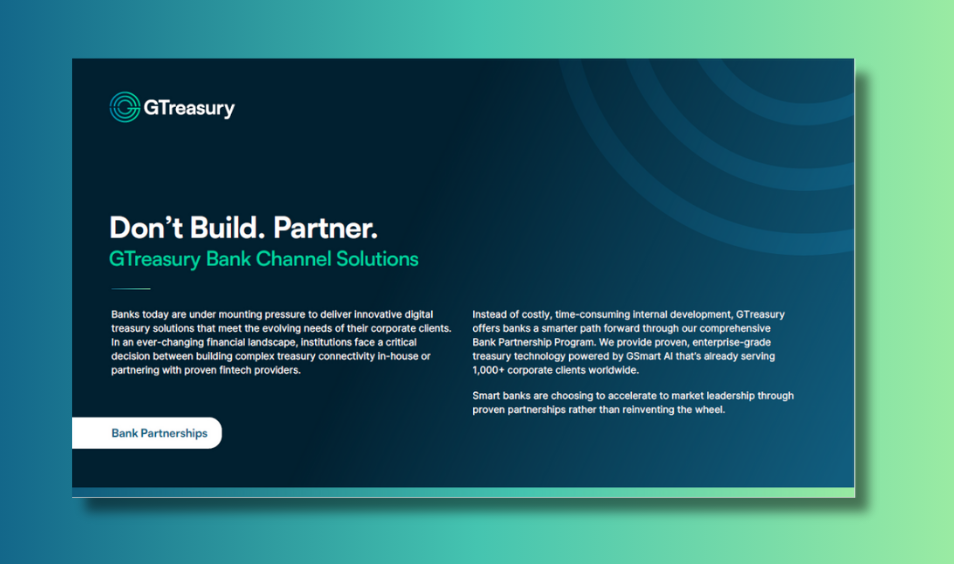

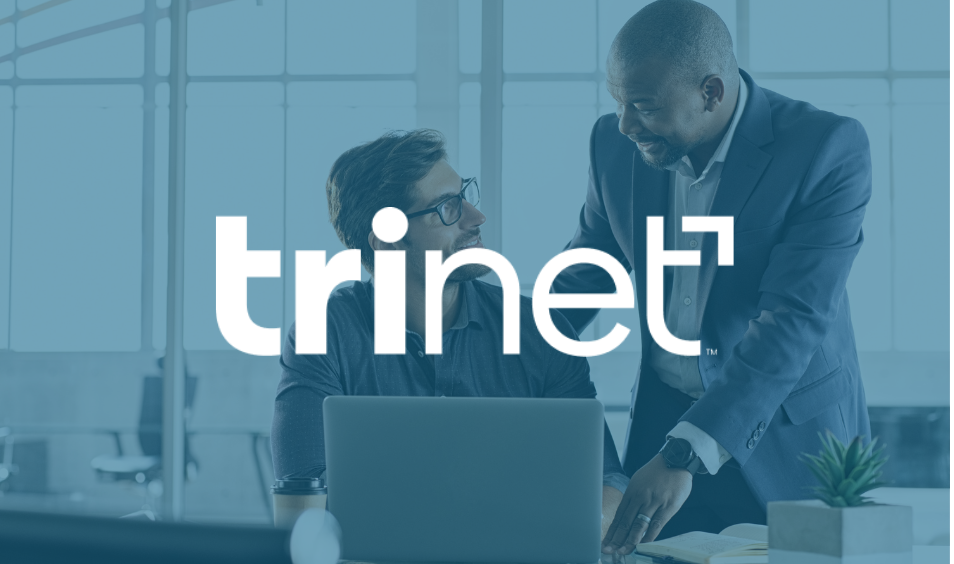

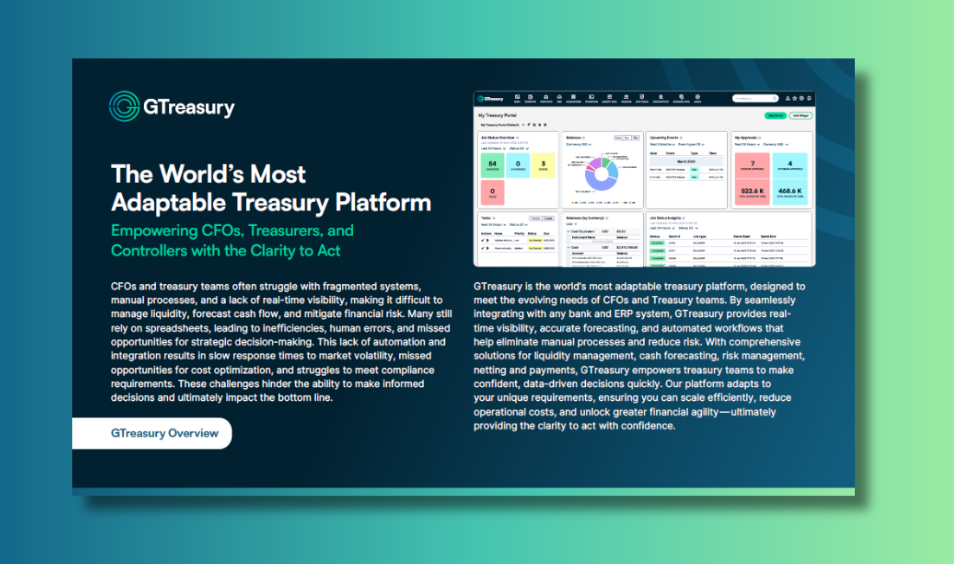
.png)




%404x.png)









